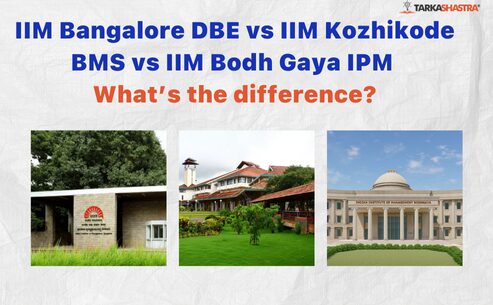Every year, thousands of bright Class 12 students aim to crack the Integrated Program in Management Aptitude Test (IPMAT)—the gateway to India’s most prestigious 5-Year BBA+MBA programs at IIM Indore, IIM Rohtak, and others. But a common question haunts both students and parents: “Is IPMAT really that tough?”
This blog answers that question honestly and analytically. From understanding the exam structure, syllabus complexity, and cutoff trends, to comparing it with other popular entrance tests like CUET, NPAT, and SET, we dive deep into what makes IPMAT both challenging and rewarding.
Whether you’re a student exploring post-12th management options or a parent guiding your child’s career, this blog offers a clear-eyed view of IPMAT’s difficulty level, along with actionable tips to overcome it.
By the end of this blog, you’ll not only know how tough IPMAT is, but also how to beat it.
What Makes an Entrance Exam “Tough”?
Before we answer “Is IPMAT tough?”, it’s essential to define what makes any entrance exam challenging in the first place. An exam isn’t considered tough just because the syllabus is vast or the questions are complex—it’s usually a combination of multiple factors.
Let’s break down the 5 core parameters that determine the toughness of an entrance exam:
| Parameter | What It Means in Exams | Why It Matters for IPMAT |
| Conceptual Depth | Complexity of topics and logic tested | IPMAT tests advanced Class 11–12 math, logical reasoning, and nuanced verbal skills |
| Time Pressure | Time allotted vs. number of questions | IPMAT Indore has strict sectional timing, while Rohtak packs 120 questions in 120 minutes |
| Competition Level | Number of applicants vs. selection ratio | Less than 5% make it to the PI round at top IIMs |
| Question Type Variety | Presence of MCQs, short answers, logic-based puzzles | Indore includes Short Answer (SA); Rohtak has full-length LR section |
| Negative Marking & Cutoffs | Penalty for wrong answers and sectional cutoffs | Both exams have negative marking; Indore has strict section-wise cutoffs |
In short, toughness is not just about difficulty—it’s about pressure, performance, and precision under tight timelines. And IPMAT, despite being an undergraduate exam, ticks most of these boxes.
IPMAT Indore vs IPMAT Rohtak – Which is Tougher?
The IPMAT exam is conducted by two different IIMs—Indore and Rohtak—and while both offer access to a prestigious 5-year BBA+MBA program, their exam patterns vary significantly.
So, when students ask “Is IPMAT tough?”, the answer partly depends on which IPMAT they’re referring to.
Here’s a comparison to help you understand which exam poses a tougher challenge:
IPMAT Indore vs Rohtak – Difficulty Comparison Table
| Feature | IPMAT Indore | IPMAT Rohtak |
| Total Questions | 90 | 120 |
| Sections | Quant (MCQ + SA), Verbal Ability | Quant, Verbal, Logical Reasoning |
| Question Format | MCQ + Short Answer | All MCQs |
| Negative Marking | Only MCQs (-1); No negative for SA | All sections (-1 per wrong answer) |
| Sectional Timing | Yes – 40 mins per section | No – flexible time management |
| Short Answer Section | Yes (15 questions, no options) | Not included |
| Logical Reasoning | Not included | Full section (40 questions) |
| Math Difficulty | Class 11–12 level (more advanced) | Class 9–11 level (more speed-based) |
| Scoring Strategy | Requires sectional balance + SA accuracy | Requires overall speed + accuracy |
| Overall Difficulty Level | High – Concept + Time pressure | Moderate – Speed + Reasoning combo |
Key Insights:
- IPMAT Indore feels tougher because:
- It includes a Short Answer section (no options to guess from).
- Math questions go deeper into Class 11–12 concepts.
- There’s strict sectional timing, which adds pressure.
- All three sections must meet separate cutoff scores.
- IPMAT Rohtak feels challenging because:
- It has more questions (120 in 120 minutes).
- Every incorrect answer invites negative marking.
- You need to be quick, strategic, and accurate.
Verdict: IPMAT Indore is academically more difficult, while IPMAT Rohtak is more about speed, stamina, and smart attempt selection.
IPMAT Syllabus Complexity: How Much Do You Need to Know?
To gauge how tough IPMAT is, you must first look at its syllabus. While both IPMAT Indore and Rohtak draw from school-level subjects, the depth and application of concepts make the exam challenging, even for top-performing students.
Let’s break down the syllabus by section and difficulty level.
IPMAT Indore – Syllabus Complexity
| Section | Topics Covered | Difficulty Level |
| Quantitative Aptitude (MCQ) | Arithmetic, Algebra, Geometry, Number Systems, P&C, Probability, Coordinate Geometry, Time-Speed-Distance, Mensuration, Data Interpretation | High |
| Quantitative Aptitude (SA) | Same topics as MCQ but without options – requires precise calculations and strong written reasoning | Very High |
| Verbal Ability (MCQ) | Reading Comprehension, Grammar, Para Jumbles, Cloze Test, Vocabulary | Moderate to High |
Key Challenge: The Short Answer section tests actual problem-solving, not elimination or guessing. This demands confidence in concepts and calculation accuracy.
IPMAT Rohtak – Syllabus Complexity
| Section | Topics Covered | Difficulty Level |
| Quantitative Ability | Arithmetic, Algebra, Geometry, Mensuration, DI, Number Systems, P&C, Time-Speed-Distance | Moderate to High |
| Logical Reasoning | Series, Blood Relations, Coding-Decoding, Directions, Arrangements, Critical Reasoning | Moderate |
| Verbal Ability | Reading Comprehension, Sentence Completion, Grammar, Para Jumbles, Vocabulary | Moderate |
Key Challenge: Rohtak’s Logical Reasoning section can catch students off guard if ignored during preparation. It adds a non-school dimension to the exam.
Indore vs Rohtak: Conceptual Depth Comparison
| Subject Area | IPMAT Indore (Depth) | IPMAT Rohtak (Breadth) |
| Math/Quant | Advanced | Standard |
| Verbal Ability | Similar across both | Similar across both |
| Logical Reasoning | Not included | Full section |
| Unique Feature | Short Answer (No MCQ) | 120 MCQs – speed game |
Summary: IPMAT isn’t tough because of what it asks, but how deeply and how quickly you’re expected to answer. Especially in Indore, even familiar concepts become tough over time and under precision pressure.
The Competition is Real: Selection Ratio & Cutoffs
Another major factor behind IPMAT’s perceived difficulty is the extremely low selection ratio. With thousands of bright students applying and only a few hundred shortlisted, competition becomes intense, especially for IIM Indore.
Let’s look at the numbers from IPMAT 2024 and understand what you’re up against.
IPMAT 2024 Statistics – Indore vs Rohtak
| Metric | IIM Indore | IIM Rohtak |
| Total Registrants | ~40,000 | ~14,766 |
| Appeared for Exam | ~28,596 (positive raw scores) | ~13,414 |
| Candidates Shortlisted for PI | 824 | 831 |
| Selection Ratio | ~4% | ~6% |
| Cutoff Trend | Rising year-on-year | Slight dip in 2024 |
| 2024 General Category Cutoff | ~300+ (sectional cutoffs apply) | 301 (overall) |
Safe Score Targets for 2026 (General Category)
| Institute | Safe Raw Score | Strategy Tip |
| IIM Indore | 300+ | Clear each sectional cutoff, especially in Verbal and SA |
| IIM Rohtak | 400+ | Focus on accuracy over speed; avoid guesswork due to negative marking |
Key Insight: Indore’s selection is section-sensitive—you can have a grand total but still miss the shortlist if one section is weak. Rohtak, on the other hand, shortlists based on total score (normalised), but the number of questions makes it a race against time.
Cutoff Difficulty Summary
- IIM Indore: Tough due to three separate sectional cutoffs + SA section + fewer PI calls
- IIM Rohtak: Slightly more forgiving but demands high speed and precision across all 120 questions
In both cases, you’re competing with some of the sharpest Class 12 minds in the country. That makes IPMAT competitive—and therefore, challenging.
Student Sentiment – What Toppers Say About IPMAT Difficulty
To get a real sense of IPMAT’s toughness, there’s no better source than the voices of those who’ve been there, cracked that. Every year, top scorers and successful IPMAT aspirants share their experiences online—on YouTube, Quora, or in interviews. A few themes emerge repeatedly, offering both insight and reassurance.
Here’s what IPMAT toppers typically say:
“It’s Not Impossible, But It’s Not Like School Exams Either.”
Many toppers emphasise that IPMAT requires a mindset shift. Unlike board exams, it’s not just about theory—it’s about applying concepts under pressure, especially in math and logical reasoning.
“I was good at math in school, but the SA section in Indore made me rethink my approach. I had to learn how to write accurate, typed answers under stress.”
— Aarav Sharma, IPMAT Indore 2024 Topper
“Verbal Can Make or Break Your Score”
A surprising number of toppers admit that they underestimated the Verbal Ability section, especially for IPMAT Indore, where it has the highest sectional cutoff.
“Most of my prep time went into Quant. But I almost missed the cutoff in Verbal—that taught me how balanced your prep has to be.”
— Simran Kaur, IPMAT Indore PI Shortlisted Candidate
“Rohtak’s Speed Game is Draining”
Those who cracked IPMAT Rohtak often describe it as a test of stamina and speed, rather than pure difficulty.
“Attempting 120 questions in 120 minutes—with negative marking—is mentally exhausting. You can’t afford to lose focus even for a minute.”
— Kunal Mehta, IPMAT Rohtak Admit 2024
Common Sentiments Shared by Toppers
| Sentiment | What It Means |
| “Mocks helped more than books.” | Time management and decision-making are best learned through practice exams. |
| “SA questions gave me anxiety.” | Indore’s no-option format is high-stress if you’re not well-prepared. |
| “Logical Reasoning caught me off guard.” | Many overlook LR while preparing for Rohtak—leading to lower scores. |
| “Verbal was the toughest for me.” | High cutoffs and complex RCs make this section a silent killer. |
Takeaway: IPMAT isn’t tough in isolation, but the combination of precision, speed, balance, and pressure makes it uniquely challenging. However, toppers agree: with a plan, practice, and presence of mind, it’s absolutely crackable.
Comparison With Other Exams – IPMAT vs CUET, NPAT, SET
A common myth is that IPMAT is just another undergraduate management exam, like CUET (for BBA), NPAT (for NMIMS), or SET (for Symbiosis). But the reality is quite different.
IPMAT isn’t just a test of aptitude—it’s the only direct pathway to the IIMs right after Class 12. Its rigour, structure, and selection process make it more demanding than its peers.
Let’s break it down:
IPMAT vs CUET, NPAT & SET – Difficulty & Outcome Comparison
| Factor | IPMAT (Indore/Rohtak) | CUET (BBA) | NPAT (NMIMS) | SET (Symbiosis) |
| Target Institutes | IIM Indore, IIM Rohtak, IIM Ranchi | DU, BHU, etc. | NMIMS Mumbai & campuses | Symbiosis (SCMS Pune, Noida) |
| Exam Sections | QA, Verbal (both); LR for Rohtak | General Aptitude + Subject | QA, Reasoning, Verbal | General, QA, Reasoning |
| Question Types | MCQ + Short Answer (Indore), MCQs (Rohtak) | MCQ | MCQ | MCQ |
| Negative Marking | Yes (-1 per wrong in MCQs) | Yes | No | No |
| Selection Ratio | 4%–6% | 10–15% | 4% | – |
| Interview/PI Round | Yes (Indore & Rohtak) | Yes | No | Yes |
| Difficulty Level | Moderate to High | Low to Moderate | Moderate | Moderate |
| Career Outcome | BBA+MBA at IIMs; ₹20+ LPA avg CTC | UG only (3-year BBA) | UG only (BBA) | UG only (BBA) |
Key Reasons Why IPMAT Feels Tougher:
- Post-exam Interviews: Unlike most exams, cracking the written test isn’t enough—you still need to face a rigorous PI round.
- Short Answer Format (Indore): Demands precise written solutions—no guessing.
- Negative Marking + Speed (Rohtak): Every wrong attempt counts, and time is tight.
- High ROI Pressure: Getting into an IIM at 17 is a massive opportunity—students feel the stakes are higher.
Verdict: If you compare only question difficulty, IPMAT may feel similar to others. But when you add selection rate, competition, pressure, and long-term outcomes, IPMAT easily becomes the toughest among UG management entrances.
Is IPMAT Tougher Than CAT?
It might seem unfair to compare an undergraduate entrance exam (IPMAT) with a postgraduate-level management test (CAT). Still, the comparison comes up often, especially among coaching aspirants and Class 12 students eyeing long-term MBA goals.
So, is IPMAT tougher than CAT?
The short answer: No, but it’s more demanding than expected.
CAT vs IPMAT – A Fair Comparison
| Factor | CAT (Common Admission Test) | IPMAT (Indore/Rohtak) |
| Eligibility | Graduation (final year or completed) | Class 12 (appearing or passed) |
| Exam Sections | QA, DILR, Verbal Ability | QA, Verbal (both); LR in Rohtak only |
| Exam Duration | 120 minutes (40 mins per section) | 120 minutes (fixed in Indore; flexible in Rohtak) |
| Question Types | MCQs + TITA (Type in the Answer) | MCQs + Short Answer (Indore) |
| Negative Marking | -1 for MCQs | -1 for MCQs; no negative in SA (Indore) |
| Difficulty Level | Very High | Moderate to High |
| Competition Pool | Graduates (with 15–20 years of schooling) | Class 12 students (typically age 17–18) |
| Selection Ratio | ~2%–3% | ~2%–6% |
| Output | MBA admissions | 5-year IPM (BBA + MBA) admissions |
So Why Do People Say IPMAT Feels Tougher?
- For its target age group, IPMAT is exceptionally rigorous. You’re asked to solve math at the level of CAT (minus DILR) at 17.
- Sectional cutoffs in Indore create additional pressure—you can’t afford to be weak in any area.
- Rohtak’s question density (120 in 120 minutes) simulates CAT-like stress but without the maturity buffer that CAT-takers often have.
Think of IPMAT as a “Mini-CAT” designed for school students—but with CAT-level intensity baked in.
Final Verdict
- CAT is objectively tougher in terms of conceptual depth and exam maturity.
- But IPMAT is subjectively tougher for its audience—school students who may have never faced aptitude tests of this style and speed.
So if you’re preparing for the IPMAT, don’t underestimate it. Just because it’s a Class 12-level exam doesn’t mean it’s a cakewalk.
What Makes IPMAT Manageable (If Not Easy)?
After reading about the competition, time pressure, and complex question types, you might think: “IPMAT sounds impossible!” But hold on—IPMAT is tough, yes—but it’s also beatable.
In fact, many toppers describe it as “a manageable challenge” once you understand its structure and plan your preparation smartly.
Let’s explore what actually makes the IPMAT approachable for serious aspirants.
Reasons Why IPMAT Is Manageable
| Factor | Why It Helps You |
| Syllabus Is Based on School Concepts | Most Quant and Verbal topics come from Class 9–12 (no separate GK or Business section) |
| Predictable Exam Pattern | Exam structure hasn’t drastically changed in years—easy to build a plan |
| Focused Target Institutes | Only a handful of colleges accept IPMAT, so you can prepare with precision |
| Early Notification & Exam Window | IPMAT is held in May–June, post boards—gives clarity on timelines |
| Freedom to Choose Exam(s) | You can apply to Indore, Rohtak, or both—based on your strengths |
| No Need for Commerce Background | Open to Science, Arts, and Commerce students alike |
| SA Section Has No Negative Marking (Indore) | Great opportunity to score without penalty |
What Smart Students Do Right
- Balance School + Entrance Prep: Since the syllabus overlaps, many students prepare for IPMAT alongside Class 12 board studies.
- Start Early in Class 11: The best-performing students begin with NCERT Math and light aptitude practice during Class 11 itself.
- Focus on Quality Practice Over Quantity: Instead of solving 1,000 questions, they focus on concept clarity + mock test analysis.
Remember: IPMAT is not a memory test—it’s a logic + application test. If you build a thinking mindset, you’re already halfway through.
Bottom Line
While IPMAT can’t be called easy, it’s definitely manageable for anyone who:
- It is consistent with practice
- Builds a balanced prep strategy
- Avoids last-minute cramming
Crack IPMAT not with brute force, but with strategy, structure, and self-discipline.
Common Mistakes That Make IPMAT Feel Tougher
Sometimes, it’s not the exam that’s inherently difficult—it’s the way students approach it that makes it feel tougher than it actually is. Year after year, even strong aspirants fall short due to avoidable mistakes.
Here are the top mistakes that can derail your IPMAT preparation—and how to fix them:
1. Ignoring Sectional Cutoffs (Indore)
IPMAT Indore doesn’t just care about your total score—it requires you to clear all three sections individually (QA-MCQ, QA-SA, and Verbal). Students often over-focus on Quant and completely ignore Verbal or SA sections.
Fix: Allocate equal prep time to all three sections and monitor your sectional performance in mocks.
2. Blind Guessing (Especially in Rohtak)
Rohtak has 120 questions with -1 negative marking for each incorrect answer. A few careless guesses can ruin your accuracy and drag your score below the cutoff.
Fix: Attempt only those questions where you are 80% confident or more. Precision matters more than attempts.
3. Skipping Short Answer (SA) Practice (Indore)
The SA section in Indore is a scoring goldmine—no options, no negative marking. But many students avoid it because it looks scary.
Fix: Practice typing exact answers under time pressure. Learn to write clean steps before you enter your final answer.
4. Underestimating Verbal Ability
Verbal had the highest sectional cutoff in IPMAT Indore 2024. Many Quant-heavy students ignore it until the last minute.
Fix: Build vocabulary and practice RCs daily. Focus on grammar, sentence correction, and paragraph jumbles.
5. Not Solving Timed Mock Tests
Mock tests are your only way to simulate real exam conditions. Without them, you won’t know how you perform under stress or time limits.
Fix: Take at least 15–20 full-length mocks, and analyse every error thoroughly.
6. Over-focusing on One Section
Many students spend 70–80% of their prep time on Quant, thinking it’s the hardest. But IPMAT rewards balance, not bias.
Fix: Create a weekly plan where each section gets its due time. Consistency > intensity.
Quick Recap: Mistakes to Avoid
| Mistake | What to Do Instead |
| Ignoring weak sections | Balance all three sections equally |
| Blind guessing in Rohtak | Attempt only when confident |
| Skipping mock analysis | Review every test thoroughly |
| Avoiding SA practice (Indore) | Practice exact written answers under pressure |
| Underestimating Verbal | Focus on RCs, grammar, vocab daily |
| Studying without a plan | Build a month-by-month strategy |
Final Word: These mistakes aren’t fatal, but if left uncorrected, they make IPMAT feel like an impossible mountain. Avoid them early, and the climb becomes much smoother.
How to Beat the Difficulty – Preparation Strategies That Work
Now that we’ve understood why IPMAT feels tough and what mistakes to avoid, let’s focus on what actually works. Cracking IPMAT isn’t about being a genius—it’s about being strategic, consistent, and exam-smart.
Here’s a practical prep framework used by toppers and mentors across the country.
Step 1: Build Strong Basics (Class 11–12 Concepts)
Start with NCERT Math for classes 9 to 12. Arithmetic, Algebra, and Geometry form the backbone of IPMAT Quant.
- Focus on topics like Percentages, Time-Speed-Distance, Profit & Loss, Equations, and Mensuration.
- For Verbal, build grammar fundamentals and reading habits.
Recommended Resources:
- Quant: RS Aggarwal, Arun Sharma (Level 1–2)
- Verbal: Word Power Made Easy, Wren & Martin
Step 2: Practice Sectionally, Under Timed Conditions
IPMAT Indore has sectional time limits, and Rohtak demands speed across 120 questions. That means you must train for time as much as for knowledge.
- Take 40-minute practice sets for each section.
- Use stopwatches, online mock portals, or apps to simulate exam pressure.
Step 3: Focus on the SA Section (Indore Only)
Short Answer questions can significantly boost your score without negative marking, but only if you’re accurate.
- Type out exact numerical answers during practice.
- Work on approximation, neat calculations, and step-by-step thinking.
Step 4: Make Verbal a Daily Habit
Many students ignore Verbal until it’s too late. But this section often has the highest cutoff, mainly in Indore.
- Read 1 editorial or article daily (The Hindu, Indian Express, Aeon).
- Learn 10 new words a day with meanings, usage, and synonyms.
- Practice grammar through sentence correction drills.
Step 5: Master Logical Reasoning (Rohtak Only)
Rohtak includes 40 LR questions. These are not directly taught in school but can be scored with consistent practice.
- Prioritise topics: Blood relations, arrangements, directions, coding-decoding.
- Focus on solving puzzles quickly and accurately.
Suggested Timeline for Class 11 & 12 Students
| Period | Focus Area |
| Class 11 | Basics: NCERT math, grammar, reading |
| Class 12 (early) | Advanced QA, mocks, RC, logical reasoning |
| Final 3 months | Full-length mocks + PI preparation |
Mock Test Strategy
| Action | Purpose |
| 15–20 full-length mocks | Develop speed, stamina, and strategy |
| Detailed mock analysis | Identify weak areas and time traps |
| Sectional tests weekly | Reinforce consistency |
Toppers Say: “You don’t need to study 10 hours a day. You need 2–3 focused hours daily—consistently—for 6–8 months.”
Final Prep Checklist
- Concept clarity across all sections
- 10+ mocks attempted and analysed
- Verbal and SA practiced weekly
- Time-tested exam-day strategy
- PI preparation started post-shortlist
Bottom Line: IPMAT is tough—but it’s a challenge you can train for. With a structured prep strategy and a disciplined schedule, you’ll not only survive the paper—you’ll thrive in it.
Final Verdict: Is IPMAT Tough?
Let’s come back to the question that started it all: “Is IPMAT tough?”
The honest answer? Yes. But not in the way most people think.
It’s not tough because the syllabus is massive. It’s not tough because the questions are alien. It’s tough because of how early, competitive, and high-stakes it is for a Class 12 student.
Why IPMAT Feels Tough
- Low Selection Ratio: Only ~2–6% of students make it to the interview round.
- Balance Required: You must be good at Quant and Verbal, and LR (Rohtak)—you can’t hide your weak areas.
- Time Pressure: Whether it’s the SA section (Indore) or 120 MCQs (Rohtak), every second counts.
- Interview Stage: Cracking the written test is just half the battle—PI shortlists are brutally competitive.
- Maturity of Test Format: Short Answer questions, sectional cutoffs, and normalisation demand smart prep.
Why It’s Still Worth It
For all its difficulty, IPMAT offers a reward few other exams do—a direct path to the IIMs at 17.
By age 23, you could:
- Have a BBA+MBA from India’s best B-school
- Be earning ₹20–30 LPA in consulting, analytics, or marketing
- Have studied abroad through exchange programs
- Be working at McKinsey, Amazon, Goldman Sachs, or running your own startup
You’re not just cracking an entrance exam. You’re unlocking a decade-long head start on your career.
Final Word
If you’re someone who:
- Enjoys problem-solving and numbers
- Is curious about business, psychology, or economics
- Doesn’t want to gamble everything on CAT at age 21
- Is ready to study smart and stay consistent
…then yes—IPMAT is challenging, but it’s your best challenge yet.
Don’t ask if it’s tough. Ask if it’s worth it. And the answer is absolutely yes.
At Tarkashastra, we specialise in helping aspirants like you simplify IPMAT prep with structured plans, expert faculty, personalised guidance, and regular mock tests. Whether you’re targeting Indore, Rohtak, or both, we’ve helped students across all streams and cities secure their dream IIM seat.
If you’re serious about IPMAT 2026, don’t do it alone. Let Tarkashastra be your strategy partner from Day 1.
Explore our IPMAT courses, join free webinars, or book a mentorship call today at www.tarkashastra.co.in
Frequently Asked Questions (FAQs) – Is IPMAT Tough?
1. What makes IPMAT a challenging entrance exam?
IPMAT is tough because it combines school-level concepts with competitive exam pressure. It also includes time-bound sections, negative marking, and sectional cutoffs (Indore). The competition is intense, with less than 5% getting shortlisted for interviews.
2. Is IPMAT tougher than CAT?
While CAT is conceptually more advanced, IPMAT feels tougher for Class 12 students due to their relative inexperience. IPMAT demands early maturity in problem-solving, speed, and accuracy, especially with the SA section in Indore and high question volume in Rohtak.
3. Can a student from a non-commerce background crack IPMAT?
Absolutely. Students from the Science or Humanities streams have successfully cracked IPMAT. Since the syllabus focuses on logical and mathematical aptitude, the academic stream doesn’t create a barrier.
4. Why is the Short Answer (SA) section in IPMAT Indore considered difficult?
The SA section requires you to type exact answers with no options to choose from and no partial marks. It tests true conceptual clarity and is time-intensive, which increases pressure during the exam.
5. Is IPMAT Rohtak easier than IPMAT Indore?
In terms of syllabus depth, yes. Rohtak focuses more on speed and accuracy with MCQ-based questions and logical reasoning. But the sheer number of questions (120 in 120 minutes) and complete negative marking make it tricky to navigate.
6. How much time should I dedicate daily to prepare for IPMAT?
A consistent 2–3 hours per day for 6–8 months is ideal. Focused daily practice with weekly mock tests helps build stamina and mastery across all sections without burnout.
7. Is coaching mandatory to crack IPMAT?
Not mandatory, but highly recommended. Coaching provides structured study plans, mock tests, and doubt support. Many toppers combine coaching with self-study for the best outcomes.
8. What is the success rate of IPMAT aspirants?
The success rate is very low—less than 5% for IIM Indore and about 6% for IIM Rohtak. Thousands of aspirants compete for a few hundred seats, making it one of the most selective UG entrance exams in India.
9. How necessary are mock tests for IPMAT preparation?
Mock tests are essential. They simulate real exam conditions and reveal gaps in accuracy, time management, and topic-wise strength. Reviewing mocks is where most learning happens.
10. Is Verbal Ability difficult in IPMAT?
Yes, especially in IPMAT Indore, where it had the highest cutoff in 2024. It includes RCs, grammar, para jumbles, and vocabulary, and requires daily practice to maintain speed and accuracy.
11. Can a student with weak math still crack IPMAT?
Yes, but it will require deliberate effort to strengthen the basics. Start with Class 9–10 NCERTs and gradually move to IPMAT-level Quant questions. Focus on accuracy, especially in the SA section.
12. Does IPMAT include General Knowledge or Current Affairs?
No, IPMAT does not test GK. It focuses only on Quantitative Aptitude, Verbal Ability, and Logical Reasoning (Rohtak only). This is an advantage for students who prefer logical over factual prep.
13. What books should I refer to for IPMAT preparation?
Use RS Aggarwal and Arun Sharma for Quant, Word Power Made Easy for Vocabulary, and Wren & Martin for grammar. Supplement with mock test series from reputed coaching institutes.
14. Is Logical Reasoning complex in IPMAT Rohtak?
Not conceptually difficult, but it can be time-consuming if not practised regularly. Focus on high-weightage topics like puzzles, arrangements, directions, and series to improve your score.
15. What is a safe score in IPMAT Indore 2026?
Aim for 300+ with individual sectional cutoffs cleared. Even a high total score won’t help if you fail to qualify in just one section, especially QA-SA or Verbal.
16. What is a good attempt strategy for IPMAT Rohtak?
Try to attempt around 90–100 questions with 85–90% accuracy. Do not guess blindly due to negative marking. Manage time carefully across all three sections since there’s no sectional timer.
17. How early should I start preparing for the IPMAT?
Ideally, start in Class 11 with light preparation and ramp it up in Class 12. This gives you enough time to cover concepts, practice SA, and build confidence through mocks.
18. How important is the Personal Interview after IPMAT?
Very important. Even after cracking the written exam, your final admission depends on your PI’s performance. Prepare to talk about your goals, interests, and academic background confidently.
19. Can I appear for both IPMAT Indore and Rohtak?
Yes, and it’s highly advisable. The exams have separate registrations but don’t clash in timings. Applying to both increases your chances of entering an IIM via IPM.
20. Is IPMAT similar to CUET or NPAT?
Not really. CUET and NPAT are easier in structure and do not have SA or PI rounds. IPMAT is more competitive, selective, and leads to IIM-level placements and education.
21. What role does accuracy play in IPMAT?
A huge one. With -1 negative marking in MCQs and time pressure, accuracy becomes more valuable than speed. Reckless guessing can cost you selection.
22. Can I prepare for IPMAT along with Class 12 boards?
Yes, especially since the Quant syllabus overlaps with school math. Effective time management and prioritising practice over theory help students balance both.
23. Are IPMAT cutoffs increasing every year?
Yes, especially for IIM Indore. Rising awareness and competition mean the bar is going higher. Cutoffs for Verbal and QA-SA have particularly seen an upward trend.
24. Is it possible to prepare for IPMAT without coaching in rural areas?
Yes, with the right online resources, free YouTube lessons, and mock test platforms, self-study is very much possible. Just ensure you stick to a clear prep timeline.
25. What is the biggest myth about IPMAT?
That it’s “just a school-level aptitude test.” In reality, IPMAT demands competitive strategy, consistent practice, and exam temperament. Treating it lightly is a big mistake.







